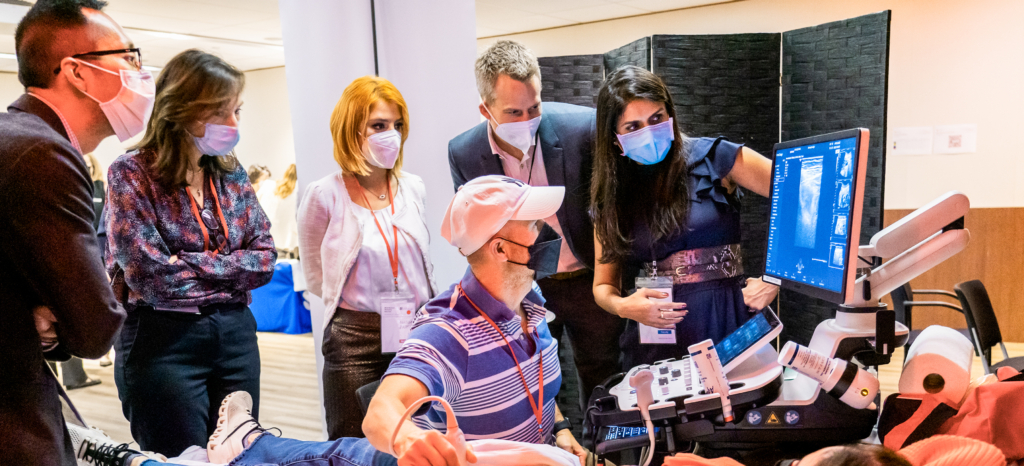

Understanding what is happening inside the gut is essential to caring for people with Crohn’s disease. Disease monitoring is critical to diagnose the condition, evaluate disease progression, and assess response to treatments, but current options have significant limitations. Biomarker tests, like C-reactive protein and fecal calprotectin tests, are imperfect corollaries to disease activity and cannot pick up the location, extent, and severity of inflammation. Moreover, the tests need to be used in combination with imaging, currently done through endoscopy, CT, or MRE, which can be invasive, expensive, and can expose patients to radiation or require anesthesia.
To push the field forward, Helmsley is committed to supporting research and training on monitoring technologies that hold promise to achieve better care and outcomes for people with Crohn’s disease.
One such option is point-of-care intestinal ultrasound, which is emerging as a low-cost, non-invasive, convenient tool that allows gastroenterologists to identify changes in bowel wall thickness, vasculature and blood flow, signs of inflammation, and strictures — all important indicators of disease activity. Furthermore, preliminary evidence suggests ultrasound is preferred by patients to endoscopy and MRE, has comparable accuracy in measuring disease activity, and may help improve outcomes by making monitoring more accessible, particularly in low resource environments. Using ultrasound at point-of-care and discussing findings with patients in real-time can be invaluable to help patients understand their disease, build trust with providers, and allow a more collaborative approach to developing agile treatment plans that patients are more motivated to follow.
Outside of select academic inflammatory bowel disease (IBD) centers, uptake of point-of-care intestinal ultrasound has been slow, particularly in the United States. It has previously not been part of the training of gastroenterologists or IBD specialists, and insurance coverage and provider reimbursements have not been well-defined. However, support from funders like Helmsley and others has contributed to slow but steady growth globally — meaning more providers are incorporating intestinal ultrasound in their care for people with Crohn’s and IBD. Centers in New York and Chicago, for example, have seen increasing demand both from patients who prefer to be assessed with intestinal ultrasound and from clinicians who want to learn the technique.

The International Bowel Ultrasound Group held trainings at the Icahn School of Medicine in Mount Sinai, which has a major IBD center in New York where intestinal ultrasound is practiced.
Helmsley’s efforts to support the incorporation of point-of-care intestinal ultrasound as part of the standard of care address the need for a multi-faceted approach to diagnosis and monitoring. Our grantees include the International Bowel Ultrasound Group (IBUS), which is leading the way in training gastroenterologists and overcoming obstacles to use. To date, IBUS has held training sessions in New York, Chicago, Los Angeles, India, and Europe. With Helmsley’s support, IBUS is training gastroenterologists across the U.S. and developing and validating standardized Crohn’s disease activity and bowel damage indices using intestinal ultrasound. IBUS is also surveying patients to understand their experience with intestinal ultrasound compared to other imaging modalities.
Helmsley has also awarded grants focusing on intestinal ultrasound to the University of Chicago and Cleveland Clinic. The goal of the University of Chicago project is to develop and widely share an IBD monitoring and prevention program using intestinal ultrasound and to create an intestinal ultrasound research alliance in the U.S. and Canada. This grant will also support international convenings of experts, including IBUS, to foster collaborations. With Helmsley’s support, collaborators at the Cleveland Clinic and the University of Calgary, led by Dr. Florian Rieder, will develop an ultrasound index to allow cost-effective, point-of-care monitoring of stricturing Crohn’s disease progression and response to therapy. Currently, no such monitoring tools are available, limiting the ability to conduct clinical trials and gain regulatory approval of much-needed novel therapeutics in this area.
Investment in non-invasive, point-of-care, and cost-effective diagnostic tools and technologies is essential for improving care for people with Crohn’s disease. If point-of-care intestinal ultrasound can gain wider use by those treating Crohn’s patients, we may be one step closer to making their lives better — a goal that drives all that we do at Helmsley.
References and Resources:
International Bowel Ultrasound Group website, including references and training opportunities: https://ibus-group.org/
Rubin, David T. “The Arrival of Intestinal Ultrasound for Inflammatory Bowel Disease Care in the United States.” Gastroenterology & Hepatology 19.3 (2023): 147.
Dolinger, Michael Todd et al. “Guide to Intestinal Ultrasound Credentialing, Documentation, and Billing for Gastroenterologists in the United States.” The American journal of gastroenterology, 10.14309/ajg.0000000000002253. 20 Mar. 2023, doi:10.14309/ajg.0000000000002253
Rohatinsky, Noelle et al. “Crohn’s Disease Patient Experiences and Preferences With Disease Monitoring: An International Qualitative Study.” Crohn’s & colitis 360 vol. 5,2 otad012. 25 Feb. 2023, doi:10.1093/crocol/otad012